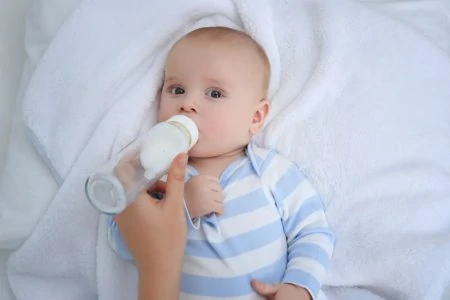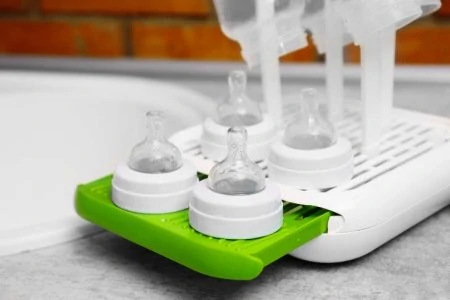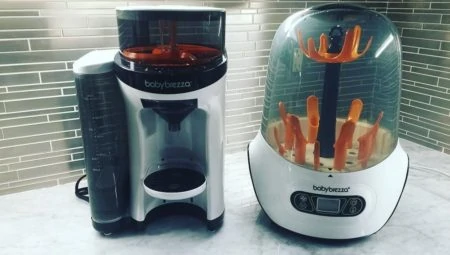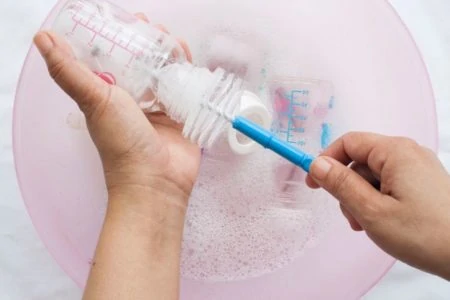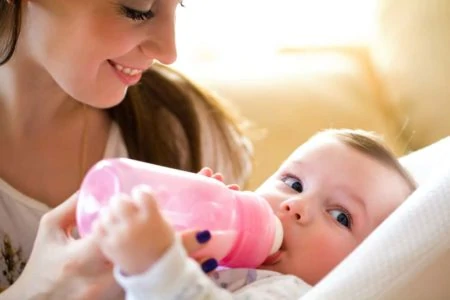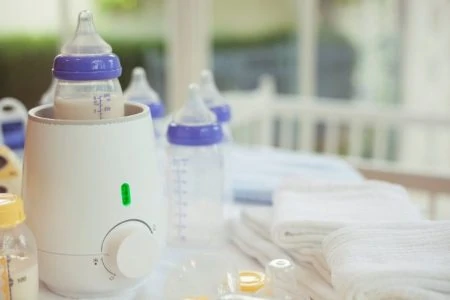There’s nothing worse than trying to put off a crying, hungry baby. When they want food, they want it now and have little patience for the time it takes to heat a bottle safely.
So, how can you warm a bottle quickly without causing harm to your baby? By researching and experimenting, we’ve compared all the ways to warm baby bottles to find the safest and best methods to get your baby fed faster.
This is what we’ve learned.
Key Takeaways
- It is not necessary to heat a baby’s bottle, it’s simply a matter of preference.
- The goal is not to heat the bottle of milk but rather to warm it. Exposing milk to temperatures that are too high destroys its natural enzymes and immunizing properties.
- Don’t warm bottles in the microwave, as it can result in uneven heating, which can burn a baby’s mouth.
- Heating bottles on the stovetop can also cause milk to heat unevenly, warm too quickly, or overheat all at once.
- Glass baby bottles are a great choice to give you peace of mind, but some parents are dissuaded by their weight and the possibility of breakage. All plastic baby bottles currently sold in the U.S. are manufactured without bisphenol A (BPA).
- Always test the milk before giving the bottle to your baby to avoid burning their mouth.
The Basics of Bottle-Heating
First of all, let’s make one thing clear: It’s not necessary to heat a baby’s bottle; it’s simply a matter of preference (1). While young babies may especially have a preference for warm milk, older babies may be more open to tolerating lukewarm or even cold milk.
When a baby nurses, the milk that is released is warmed to body temperature, around 98.6 degrees. For us adults who like our coffee around 160 degrees, that seems downright icy. This is why “heating” a bottle is a misnomer.
Take Note
Instead of working to “heat” the bottle, try to gently raise the temperature to match the typical temperature of the body. This will preserve the nutrients in the milk and prevent burning (2).
There are several different ways to warm a bottle:
- Microwave (not recommended).
- Baby bottle warmers.
- Stove-top (not recommended).
- Counter-top methods.
- Using tap water.
Warning
Bottles that are microwaved continue to “cook” after they’re removed, making the temperature increase further and putting your baby at risk for burns.
Heating bottles on the stove-top in boiling water can also cause milk to heat unevenly, warm too quickly, or overheat all at once. You can heat water on the stove and then use it to warm a bottle, but make sure to remove it from the stove before putting the bottle in to warm. Bottle warmers or a mug of warm tap water are a safer bet.
If your baby prefers their milk warmed, check our advice below to make sure you’re reaching that perfect temperature quickly and safely.
Choose a Glass or BPA-free Bottle
When you’re heating your baby’s bottle, it’s important to be mindful of the possibility of chemical leaching. Glass baby bottles are a great choice to give you peace of mind, but some parents are dissuaded by their weight and the possibility of breakage.
The good news is that all plastic baby bottles currently sold in the U.S. are manufactured without bisphenol A (BPA). BPA makes plastics rigid, keeps plastics from growing bacteria, and prevents rust. It’s an estrogen-like chemical that can potentially cause health problems (3).
If you are using old or secondhand plastic bottles, you may want to check if they contain BPA. You may also need to check if your bottles were purchased outside the U.S. Consult the manufacturer to ask if you’re not sure.
If you prefer to use the bottles you have but aren’t sure about their BPA content, don’t worry, you can still use them! Just heat your milk or formula in a glass container, then transfer it to your existing bottles to avoid the leaching issue.
Heat Evenly
While most of these methods heat your baby’s bottle evenly, it’s always better to be safe than sorry. Gently swirl (don’t shake) the milk to mix it and ensure there are no hot spots. You want the temperature to be consistent throughout the bottle.
Test the Temperature
No matter which method you use, remember — safety first! Always test the milk before giving the bottle to your baby to avoid burning their mouth. Dab a few drops of milk onto your inner wrist; you should feel almost nothing if it’s the appropriate temperature.
Most babies prefer milk that’s as close to body temperature as possible. If you feel no warm sensation on your wrist, the temperature is perfect. If it’s slightly cool, it may still be acceptable, but if you feel any heat at all, the bottle is too hot! Wait until it cools down before offering it to your little one.
4 Ways to Safely Warm Your Baby’s Bottle
Here are four tried and tested ways to warm your baby’s milk without causing them any harm.
1. Set the Bottle in Warm Water
One of the most tried-and-true bottle-warming methods is the countertop method — and it requires no special equipment! Heat some water on the stove or in the microwave, or run the hot water tap. The water should be lukewarm but not boiling.
Remove the water from the heat source, and set the bottle in it, allowing it to sit and be gently warmed by the water. Swirl the bottle occasionally to make sure all the milk gets heated through, but avoid shaking vigorously, as this can introduce air bubbles.
This method is easy and costs nothing, but it can take several minutes to warm your baby’s bottle to the desired temperature.
2. Warm Milk Bags Under Tap Water
If you’re feeding your baby expressed milk, the breastmilk bag is your new best friend!
Because the plastic is thin and the breast milk is spread across the bag in a thin layer, you can bring it to the right temperature quickly and efficiently by running the bag under warm tap water.
When it feels like it’s heated through, transfer the milk to your bottle.
3. Prepare Formula Bottles with Warm Tap Water
If you’re mixing a bottle of formula and have a sink on hand, there’s no need to go through the extra step of heating your bottle. Simply run warm water directly into the bottle when you’re mixing your formula.
If you’re concerned about the purity of your local tap water, boil it for one minute, then allow it to cool to the appropriate temperature (98.6 degrees) before making your baby’s bottle (4).
4. Use a Bottle Warmer
There are several bottle warmer options on the market, so make sure you choose one that fits the size and shape of the bottles you’re using. These take the guesswork out of warming bottles — a simple touch of a button warms your bottle to the perfect temperature, hands-free.
There are even some that are made for the car in case you’re away from home. And if you’re formula-feeding, you can choose one that dispenses, mixes and heats the water all in one simple step. It’s like a Keurig for your baby!
